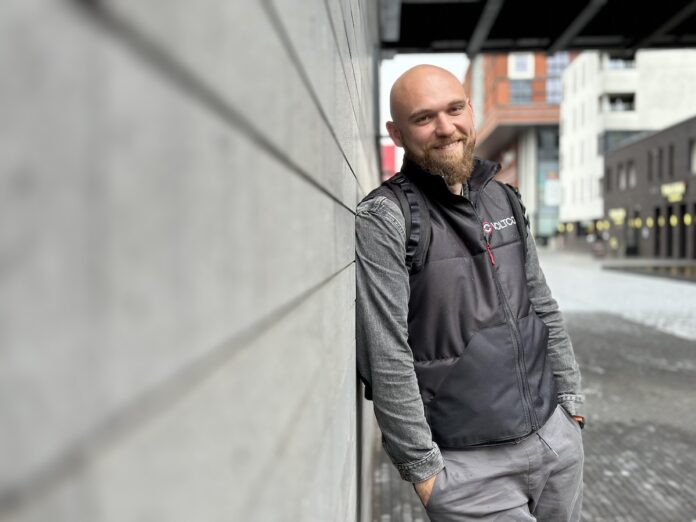Voltcore: Smart collaboration combined with innovative technologies is the key to progress in climate-tech
Statistics say heat production is the largest contributor to global CO2 emissions, accounting for around 40% of total emissions in 2023. Emerging climate-tech companies are taking up the gauntlet
Could you please introduce Voltcore and the key individuals behind its creation?
I am Vlad Batkhin, the founder and CEO of Voltcore since 2022. For more than 15 years I’ve been working in business development, complex new-tech R&D, and capital project execution in the chemical industry. My experience resulted in the foundation of Voltcore.
Voltcore is based in Luxembourg. We are a smart materials and climate-tech start-up focusing on the development, implementation, and expansion of heated polymer filament technology and various derived products. This method presents a more sustainable option compared to conventional fluid or metal-based heating systems. Our company aims to deliver high-quality, affordable, and eco-friendly heating solutions for homes and businesses, leveraging scientific research and advanced polymer nanocomposites.
What is the vision of Voltcore, and how do you plan to achieve it?
According to the International Energy Agency (IEA), in 2023 global energy-related CO2 emissions reached a new record high of 37.4 billion tonnes (Gt). The survey estimates that heating can account for 40% of total emissions, emphasizing the importance of transitioning to cleaner energy sources for heating to mitigate climate change impacts.
Taking into account the issue, at Voltcore we came up with the main mission of the company. We help fight climate change through the new generation of heating materials to economize energy and ultimately reduce CO2 emissions.
What innovations has Voltcore introduced that set you apart from competitors?
Voltcore is revolutionizing heating with an innovative material called conductive filament. This ultra-thin, durable, safe, and flexible polymer wire delivers comfortable warmth much more efficiently than traditional methods. We are also working with the infrared nature of the heat emitted by our material to direct it to the surfaces or objects that should be heated.
The key features of our innovative technology are:
Directional heating and placing our material closer to the objects allow us to minimize energy losses. With low power consumption, the technology directs heat exactly where it’s needed.
Filament starts to radiate heat immediately after being turned on which also helps to minimize timing for doing pre-heating work and if combined with smart home algorithms also significantly can reduce costs.
We can deliver natural and safe infrared heat that doesn’t overheat and overdry air. This type of heating is healthier than traditional methods like radiators, fan heaters, or convector heaters as it keeps humidity and does not propulse air with irritants and bacteria across the space.
The technology allows the affordable price to ensure heating solutions are accessible to a wide range of consumers.
We develope recycable designs for our products and broadly involve recycled materials to reduce polymer
As a result, unlike conventional solutions such as boilers and electric heaters, polymer-based heating appears to be both economical and eco-friendly thanks to lower energy consumption. Additionally, polymer-based materials are easily recycled after their lifetime ends (which is not expected to happen soon).
Although the unique features of our technology give us many opportunities to meet a wide range of global demand, our flagship product is oriented heating laminates. They provide targeted heating in any shape and area.
Who is Voltcore’s primary target audience, and how do you ensure their needs are met?
Our filament’s versatility and broad conductivity range make it suitable for nearly every heating application, from heated clothing powered by a regular power bank to demanding de-icing systems.
However, no company, especially a startup, can develop all potential applications simultaneously. That’s why we’ve chosen to focus on two key segments: mobility, with solutions for in-cabin and battery heating we are offering to OEMs, Tiers and battery packs manufacturers, and construction, with an extremely energy-efficient floor heating product with the target audience among developers, contractors, and smart-home systems integrators.
Besides the oriented heating floor laminates, our technology can be used for warm walls or ceilings, as well as in outdoor de-icing applications. Moreover, we are able to develop a special heating solution on a specific request.
By using our materials, developers and construction companies can significantly reduce both construction costs and environmental impact.
Cold weather significantly challenges electric vehicle owners, impairing their battery performance and charging speed. In the cold, EV batteries temporarily lose range, and during a deep freeze, owners face decreased battery efficiency and longer charging times.
Our battery heaters offer EV users a lightweight and safe solution to this problem, as they prevent EVs from losing their driving range.
We see interest from these two market segments and are testing our product with several well-known companies. We can achieve two goals in one go: by answering their demand, we reach our main goal — to reduce CO2 emissions. Our strategy is to achieve commercial success in these areas before expanding into other applications.
What are some of the biggest challenges Voltcore has faced, and how have you overcome them?
When you bring a new product to the market, you can face bottlenecks everywhere: production, pre-marketing, and selling.
The real challenge is turning intentions into actions. Many companies show interest in new technologies, but putting that interest into practice is often a major hurdle. Some of our clients are great at discovering new technologies, but their implementation process might be too slow. This inertia stalls progress and hampers our ability to tackle pressing issues.
To convince investors and consumers that your product is worth their attention is quite challenging, especially when you are a budding startup offering new technologies to the market. At every stage, any side involved requires minimum risks and guaranteed income, financial or environmental.
Another challenge that many big companies are facing is separation and misunderstanding between the business management and the R&D (Research and Development) departments. This separation can create a gap between R&D’s innovative ideas and the practical needs of operations and the market. The outcome is frequently misaligned efforts, missed opportunities, and less effective product development cycles.
At Voltcore we try to understand the business, sustainability, and R&D agendas of our customers to create a proper solution that will bring value to our partners.
Can you discuss any upcoming projects or developments Voltcore is working on?
In 2024, Voltcore’s success depends on two main goals: scaling our technology to the industrial level and taking our first steps toward commercialization by testing our material in client applications.
As I mentioned above, we are focusing on applications for the construction market with a floor-heating solution and the mobility industry with in-cabin and battery heating.
Achieving these milestones will set us up for a key investment decision in 2025, moving us closer to our long-term objectives. We also have prominent results on some other applications, but I’d rather keep them in stealth mode before the official launch.
How do you see the future of Voltcore, and what are your long-term goals?
Over the year, our primary technological goal is to reach TRL-7 (samples delivery, certification, and pre-ordering) for our core materials and products. To achieve this, we must launch our pilot plant, which will allow us to control the value chain and obtain the necessary certifications for both production and product, as required by most of our customers.
From a market perspective, we need to generate client interest and awareness and sell full-sized samples that can be broadly tested during the upcoming winter. In the automotive sector, we’ve already completed mutual development and broad testing of the integrated product, positioning us to secure substantial long-term agreements that will simplify our scaling plans.
These efforts will lay the groundwork for our next major step — building a fully scaled factory to optimize the process and value chain to achieve economies of scale.
Our goal is to make an investment decision on this plant in 2025, with a planned launch in 2027. This facility will have the capacity to produce approximately 2.5 million m² of heating materials, sufficient to meet demand for 2-3 automotive OEMs or to supply enough material to reheat 50,000 flats annually.
As for the long-term goals, we aim to provide best-in-class energy efficiency and cost savings, becoming the industry standard in both segments by the end of the decade.
How do you balance innovation with maintaining quality in Voltcore’s products or services?
At Voltcore we aim to create a company environment where scientists and management speak the same language, openly give feedback, and stay grounded in reality and reliability.
We understand that we cannot compromise on the quality of our product, as it directly impacts safety and client satisfaction. We never tried even to deliver samples, before we gained stability quality for filament. I’d rather postpone a new product launch than bring the product to the clients we are not sure about.
Can you share three key pieces of advice for aspiring entrepreneurs based on your experience?
First of all, when you launch a new business or offer an innovative technology to the market, you need to remember, that startups thrive by quickly testing ideas, learning from the results, and adjusting their approach. This fast cycle of experimentation, called iteration, drives them toward rapid innovation.
Unlike traditional research with its long timelines, startups should focus on quick cycles of experimentation and feedback. This “fail fast, learn faster” approach helps them find what works and what doesn’t. Therefore, startups can rapidly improve their technology, create products that meet customers’ demands, and achieve swift success.
Secondly, as I have said before, effective communication among all team members is the key to successful technological development. A diverse team, united by clear communication, can achieve exceptional collaboration and innovation.
Finally, teams that practice radical honesty — where everyone, from leaders to tech members, can share their true opinions — have a higher chance of success. Without this honesty, the risk of mistakes rises. When team members hold back, valuable insights are lost, leading to poorer decisions.
What role do partnerships and collaborations play in Voltcore’s business strategy, and how do you approach them?
Partnerships and collaborations are envisioned to play a crucial role in Voltcore’s future business strategy. Our approach to partnerships is proactive and strategic; we seek to align with organizations that share our commitment to sustainability and innovation. By fostering open communication and mutual goals, we aim to create synergies that drive progress and deliver superior solutions to our clients. We are actively exploring opportunities to collaborate with industry leaders, research institutions, and technology innovators to maximize our impact and growth potential.
How do you measure success and impact within Voltcore?
At Voltcore, we measure success and impact through several key indicators, even at our current stage of sample production and delivery to clients. Reducing the carbon footprint from heating, which significantly impacts the environment, is our top priority, and this drives all our efforts.
We focus on the performance and feedback of these initial samples, gauging success by the quality and reliability of our products, client satisfaction, and the potential for scaling up based on client interest and demand. Additionally, we assess the efficiency of our production processes and ensure our products align with sustainability goals. These metrics help us refine our technology and strategy, keeping us on the right path toward broader market adoption and long-term success.
Picture @Voltcore
More information you will find here
Thank you, Vlad Batkhin, for the Interview
Statements of the author and the interviewee do not necessarily represent the editors and the publisher opinion again.



















